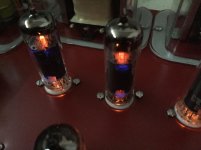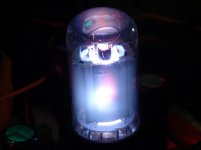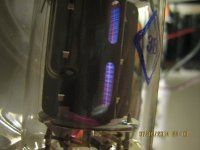I don't know of any medium which speeds up light, everything slows it down compared to a vacuum.
Q1: How?
(sorry - but this has always puzzled me!)
Q2: Additionally - what different types of vacuums has light speed been measured in?
(All are particle vacuums, but gravitational fields, magnetic fields, electric fields, and of course electromagnetic fields vary).
Q1: How?
(sorry - but this has always puzzled me!)
Q2: Additionally - what different types of vacuums has light speed been measured in?
(All are particle vacuums, but gravitational fields, magnetic fields, electric fields, and of course electromagnetic fields vary).
1. When light enters a medium (non-vacuum) its energy is absorbed by the medium and then reradiated as different photons in a chain reaction. There is a delay between the energy absorption phase and the transmission of a new photon.
A vacuum, by definition, is the absence of baryonic matter in a given volume of space.
Electromagnetic fields, gravity, and other force fields are not properties of a vacuum.
However, we do know that large gravity fields or wells can alter or bend the path of light. We see this in something called gravitational lensing. Gravitational lensing is one tool astronomers use to determine distances of objects.
Gravity also affects time as well as space. Clocks run at different speeds depending on altitude above Earth. The higher the altitude, the faster a clock ticks.
The reverse is true for velocity. The faster the clock moves, the slower it ticks.
These speed changes are not trivial. GPS satellites have their clocks adjusted for both the effect of gravity (its absence) and its orbital velocity so that they match the rate time is observed on the surface of Earth. This needs to be done so that distances and GPS positions on the Earth's geoid can be accurately displayed.
GPS satellite systems on Earth, such as your navigation system, may also take into account the speed of light through the Earth's atmosphere and ionosphere and the angle of incidence of the signal as it propagates through the ionosphere, which will distort the path and alter its apparent position/path length.
2. I am not sure I understand the question. However, many experiments have been performed here and in the vacuum of space. The early moon missions even left special reflectors on the Moon's surface that are still used today to measure not only the speed of light, but measure the Moon's distance from Earth very precisely.
We are constantly refining the exact speed of light, but we do know it very accurately now and that number only gets better each year..
Maybe Nicko_Lps was thinking of Cherenkov radiation. Cherenkov radiation occurs when electrons move in an insulator at a speed higher than the speed of light in that insulator. Which is of course possible. And it is a blueish glow in water. It can't occur in vacuum, obviously, for the reason Loren stated.
Kenneth
Probably the coolest-looking blue light I've ever seen was the Cherenkov radiation from the NC State reactor...did a summer program there before college. No photos I've seen capture it exactly, especially with the lights off 🙂
George posted once some spectacular blue when he was torturing some 6V6GTYs I think. So nice that I kept some in my HD. TubelabTM.😀 I have also found a 6P3 kinda blue pic, don't remember if it was from George again.
It was from me 😀
1. When light enters a medium (non-vacuum) its energy is absorbed by the medium and then reradiated as different photons in a chain reaction. There is a delay between the energy absorption phase and the transmission of a new photon.
Ah yes - this is the bit I really do not understand!!
If I bombard phospher with electrons I get radiated photons, but the directions are all over the place.
With glass, water and air however (excluding surface effects) the angle of variation is zero - no diffusion at all. I have trouble accepting that light can bounce through trillions of atoms and still come out at the right frequency and angle. How does it do that?
Yet they are _in_ a vacuum. Tubes for instance only work because of the electric field. If they are not properties of a vacuum then the speed of light experiments would have to be conducted away from all electric, magnetic and gravitational fields. A test at 1G and the earth's magnetic field is just one point of speed, how do we know at 0.01G (for instance) it doesn't speed up?A vacuum, by definition, is the absence of baryonic matter in a given volume of space.
Electromagnetic fields, gravity, and other force fields are not properties of a vacuum.
The moon distance measurements seem to constantly vary as I recall - but yes - that is the only non 1G measurement made I think, although speed and distance are of course interchangeable.
All the measurements tell us are the speed of light in a vacuum at 1G gravity field. Extrapolating that to gravity wells of solar systems, galaxies, black holes etc. is just that - an extrapolation, a guess. Surely if time varies with gravity, then as a fundamental property of speed - one could say the speed varies too?
Ah yes - this is the bit I really do not understand!!
If I bombard phospher with electrons I get radiated photons, but the directions are all over the place.
With glass, water and air however (excluding surface effects) the angle of variation is zero - no diffusion at all. I have trouble accepting that light can bounce through trillions of atoms and still come out at the right frequency and angle. How does it do that?
Yet they are _in_ a vacuum. Tubes for instance only work because of the electric field. If they are not properties of a vacuum then the speed of light experiments would have to be conducted away from all electric, magnetic and gravitational fields. A test at 1G and the earth's magnetic field is just one point of speed, how do we know at 0.01G (for instance) it doesn't speed up?
The moon distance measurements seem to constantly vary as I recall - but yes - that is the only non 1G measurement made I think, although speed and distance are of course interchangeable.
All the measurements tell us are the speed of light in a vacuum at 1G gravity field. Extrapolating that to gravity wells of solar systems, galaxies, black holes etc. is just that - an extrapolation, a guess. Surely if time varies with gravity, then as a fundamental property of speed - one could say the speed varies too?
Tubes are another story. You are accelerating electrons (which do have mass, albeit tiny), not photons through the tube.
"All the measurements tell us are the speed of light in a vacuum at 1G gravity field."
I don't think so. The whole universe is a lab and experiments have been run here and in space. We have found no holes in Einstein's Theory of Relativity. As I said, gravity can bend the path of light. However, there is no measurable difference for that speed in a vacuum here on Earth or extra-solar. A black hole is a different story.
There is something called the Shapiro Effect, which is considered special case of gravitational time dilation, but it is still time dilation that produces the apparent change of the value of C when using an external inertial reference point. For instance, bouncing a laser beam off of the Moon will return with a delay, but it is due to the gravitational mass of the Moon. Anywhere along the laser's path the photons are moving at the speed of light. But from an external inertial frame you must account for the time dilation from gravity, just like they do with GPS.
Does that make sense? C is always C, but the tricky part is understanding from what inertial frame of reference you are using.
C still measures as C based on "local time", whether on Earth or at the Lagrange point between Earth and Moon.
Blue Glow
Hi Guys
I just finished off a simple little 6EM5 PP amp from odd bits and bobs I had lying around, and I turned the lights out to show my workmate the tubes in action. I noticed a couple of blue bands in two of the 6EM5 tubes, and I have never seen this type of thing before.It actually looks kind of cool and I gather from the posts I am reading that this is not a problem....?
Cheers
Hi Guys
I just finished off a simple little 6EM5 PP amp from odd bits and bobs I had lying around, and I turned the lights out to show my workmate the tubes in action. I noticed a couple of blue bands in two of the 6EM5 tubes, and I have never seen this type of thing before.It actually looks kind of cool and I gather from the posts I am reading that this is not a problem....?
Cheers
Attachments
it needs above 350-400v to shine. mine 2a3´s at 330v nothing visible.
some people says it is because of dirty vaccuum..?
some people says it is because of dirty vaccuum..?
George posted once some spectacular blue when he was torturing some 6V6GTYs I
There are two kinds of blue glow that can be emitted from a tube.
A gassy tube can emit light due to ionization of the gas inside the tube. This is actually a small scale plasma. A really gassy tube when excited by way too much electricity will glow rather brightly, especially right before it dies, or takes out amp parts. The 6V6GT shown here is a few seconds from dying.
The deep blue glow seen on the inner surfaces of the glass, and less commonly on the surface of internal components of the tube is from impurities inside the tube being excited by electron bombardment. Cobalt impurities produce the deep blue glow seen on the glass in some power output tubes.
Attachments
That looks like electrons hitting the glass. Is the blue by holes in the anode?
Yes, it is. There is a small hole at the top and bottom of each anode next to the mica spacers. For what it's worth, the tubes are all nos RCA's, and all tested well in my AVO 163 with no signs of gas. B+ is 290 Volts, self biased at approx 19 Volts and screens regulated at 250 Volts. I was just curious, as I have seen blue glow from tubes before, but never quite like this as distinct bands.
Thank you to those who replied.
Yes, it is. There is a small hole at the top and bottom of each anode next to the mica spacers. For what it's worth, the tubes are all nos RCA's, and all tested well in my AVO 163 with no signs of gas. B+ is 290 Volts, self biased at approx 19 Volts and screens regulated at 250 Volts. I was just curious, as I have seen blue glow from tubes before, but never quite like this as distinct bands.
Thank you to those who replied.
You should try the 5B/254M. I have some here that light up with Sargeant Stripes in the glass 🙂
There are three common types of blue glow I believe,
One comes from electrons hitting the glass and causing it to fluoresce, if the glass contains the right elements (presumably harmless?) That's what you see in SpreadSpectrum's photo.
The second comes from a very poor vacuum and the residual gas ionizes like a voltage regulator tube (bad valve!), which is The Gimp's photo I think.
The third is the blue glow you nearly always get between the screen grid and suppressor in pentodes, due to ionized gas being re-neutralized by the slow electrons around the suppressor, also harmless. You can see this is Wavebourn's photo. Sometimes this can reflect off the glass and be mistaken for the first type of glow, which I think is the case in Rznize's photo.
Here's an example of blue glow of the 3rd kind, between suppressor and screen; it seems that all my GU50's show that, true pentodes ...
Attachments
- Status
- Not open for further replies.
- Home
- Amplifiers
- Tubes / Valves
- blue glow, how?


